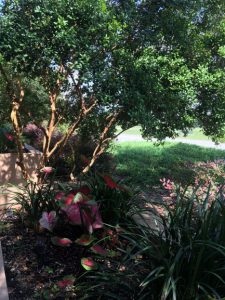When the cooler weather of fall arrives, many of us think of attracting a delightful gathering of birds to our gardens with a selection of feeders filled with a variety of seed, suet and even meal worms. It can be relaxing and satisfying to watch the birds flit around from feeder to feeder consuming what we have served up for them to eat. Knowing that my residence is also blessed with several hawks, I am hesitant to set out the feeders with the thought that those birds I’m feeding would become a smorgasbord for these larger birds.
Attracting Birds and Wildlife
An alternative to the bird-feeder collection and expense of seed is to provide a landscape which provides not only food but also places for nesting and protection from predators. An excellent resource that provides plant selections that are suitable for our 9A hardiness zone is the UF-IFAS free booklet, The Florida-Friendly Landscaping Guide to Plant Selection & Landscape Design. One of the nine principles of Florida-Friendly Landscaping is principle #5: Attract Wildlife. When creating a landscape for wildlife, plan for a multi-layer planting using trees, shrubs, grasses, perennials, groundcovers and vines. Plants should be selected that meet your specific location, i.e. sun, shade, soil pH and moisture, and height restrictions. Here are just a few of the plants which can attract not only birds but other wildlife.
Plant Selections-Shrubs and Trees
Hollies (Ilex spp.) provide not only berries (female plants), but also can provide places to nest and offer protection. Hollies can be small to medium trees such as American Holly (Ilex opaca) and Dahoon Holly (I. cassine) to Nellie Stevens Holly (Ilex x Nelllie R. Stevens) and Chinese Holly (I. cornuta), as well Yaupon holllies including the mounding habit such as Dwarf Yaupon Holly (Ilex vomitoria cvs.). Most hollies prefer full sun, but some can tolerate light shade. Slightly acidic soils so pH of 5.5-6.5 are best for these plants. (American, Nellie R. Stevens, Dahoon and Yaupon Hollies are all Florida native plants).

Another in the small tree category is Walter’s Viburnum (Viburum obovatum) which will provide cover, white flowers winter through spring, and black berries for food. the V. obovatum “Withlacoochi’ is covered early spring with white flowers. This cultivar may be limbed up as a tree or maintained as a tall shrub form. Dwarf cultivars may reach only 2-4 feet tall. Both can create a thicket and prefer part sun. Simpson’s Stopper (Myrcianthes fragrans) is another great addition for wildlife as an evergreen shrub that can become a small tree up to 30 feet with red berries for birds and wildlife. Both Walter’s viburnum and Simpson’s stopper are Florida native plants.

Beautyberry (Callicarpa americana) which is a deciduous shrub which can go to 8 feet tall. Its spring through fall flowers lead to masses of striking purple berries attractive to wildlife. It has an arching growth and prefers full sun. It flowers on new growth so can be cut back each year. Beautyberry is a Florida native plant.
Plant Selections – Vines
If you have a spot for a flowering vine, Trumpet Creeper’s (Campsis radicans), growing to 40 feet with brilliant orange flowers attract hummingbirds in full sun. Cross Vine (Bignonia capreolata) with orange-red flowers and grows to 50 feet but prefers shade, as does Coral honeysuckle. Lonicera sempervirens has red blooms from spring thorugh summer. It grows to 15 feet. All three are Florida native plants.
Plant Selections-Perennials

Finally, several perennials or grasses can be planted to attract birds, butterflies and other wildlife. The flowers of the salvia species ranging from reds, to electric blues attract butterflies and hummingbirds. Black-eyed Susan (Rudbeckia hirta) have yellow flowers and seed heads that attract birds and butterflies. Goldenrod can form large colonies with its striking golden-yellow flowers which attract wildlife and butterflies. Little Blue Stem Grass is a medium-stem bunchgrass with lavender blue stems and provides food and cover for wildlife. Black-eyed Susan, Goldenrod and Little blue stem grass are all Florida native plants.
Plant a Diverse Landscape
When you create a diverse planting to attract wildlife, you are also creating an attractive landscape that you will enjoy.
 0
0
